
DETROIT DIESEL 53
Fuel Injector 2.1.1
to a normally low pressure area in the injector assembly.
With the injector control rack held in the no-fuel position,
However, fuel droplets at the rack indicate excessive
push the handle down and depress the follower to the
leakage.
bottom of its stroke. Then very slowly release the
pressure on the handle while moving the control rack up
and down as shown in Fig. 8. until the follower reaches
CAUTION:
Do not permit the
the top of its travel. If the rack does not fall freely,
pressure in the injector tester to
loosen the injector nut, turn the tip, then retighten the
equal or exceed the capacity of the
nut. Loosen and retighten the nut a couple of times if
pressure gage.
necessary. Generally this will free the rack. Then, if the
rack isn't free, change the injector nut. In some cases it
INJECTOR VALVE HOLDING PRESSURE TEST
may be necessary to disassemble the injector to
The injector valve holding pressure test will determine
eliminate the cause of the misaligned parts.
whether the various lapped surfaces in the injector are
sealing properly.
INJECTOR HIGH PRESSURE TEST
This test is performed to discover any fuel leaks at the
Operate the pump handle to bring the pressure up to
injector filter cap gaskets, body plugs and nut seal ring.
approximately 450 psi.
The high pressure test also indicates whether or not the
plunger and bushing clearance is satisfactory.
Close the fuel shut-off valve and note the pressure drop.
The time for a pressure drop from 450 psi to 250 psi
1. Install the injector in tester J 9787.
must not be less than 40 seconds. If the pressure drop
is less than 40 seconds, check the injector as follows:
CAUTION: When testing an injector
just removed from an engine, the
1. Thoroughly dry the injector with compressed air.
flow of fuel through the injector on
the tester should be the same as in
2. Open the tester fuel valve and operate the pump
handle to maintain the test pressure.
the engine. Connections on the test
head of the tester may be changed to
3. A leak around the spray tip or seal ring usually is
obtain the correct direction of flow.
caused by a loose injector nut, a damaged seal ring or a
brinelled surface on the injector nut or spray tip.
2. Thoroughly dry the injector with compressed air.
4. A leak at the filter cap indicates a loose filter cap or
3. Check the fuel connections for leaks. If leaks have
a damaged filter cap gasket.
occurred, tighten the connections, dry the injector and
recheck.
5. A "dribble" at the spray tip orifices indicates a
leaking valve assembly due to a damaged surface or
4. With the injector rack in the full-fuel position and the
dirt. Leakage at the tip will cause pre-ignition in the
injector tester handle locked in position by means of the
engine.
handle lock (Fig. 9.), operate the pump handle to build
NOTE: A drop or two of fuel at the
up and maintain the pressure.
spray tip is only an indication of the
fuel trapped in the spray tip at the
At this time, the condition of the plunger and bushing
may be established. If there is excessive clearance
beginning of the test and is not
between the plunger and bushing, pressure beyond the
detrimental as long as the pressure
normal valve opening pressure cannot be obtained.
drop specified is not less than 40
seconds.
Replacement of the plunger and bushing assembly is
SPRAY PATTERN TEST
then required.
After completing the valve holding pressure test, open
the fuel shut-off valve, place the injector rack in the full-
Pump up the injector tester and maintain a pressure of
fuel position and operate the injector several times in
1600 to 2000 psi by actuating the pump handle. Then
succession by operating the tester handle at
inspect for leaks at the injector filter cap gaskets, body
approximately 40 strokes per minute as shown in Fig.
plugs and injector nut seal ring. If any of these
10. Observe the spray pattern to see that all spray
conditions exist, refer to Trouble Shooting Chart 5 in
orifices are open and injecting evenly. The beginning
Section 2.0.
and ending of injection should be sharp and the fuel
NOTE: It is normal for fuel to seep
injected should be finely atomized.
out around the rack due to high
pressure fuel being applied (C 1972
General Motors Corp.
1972 General Motors Corp.
July, 1972
SEC. 2.1.1 Page 7

